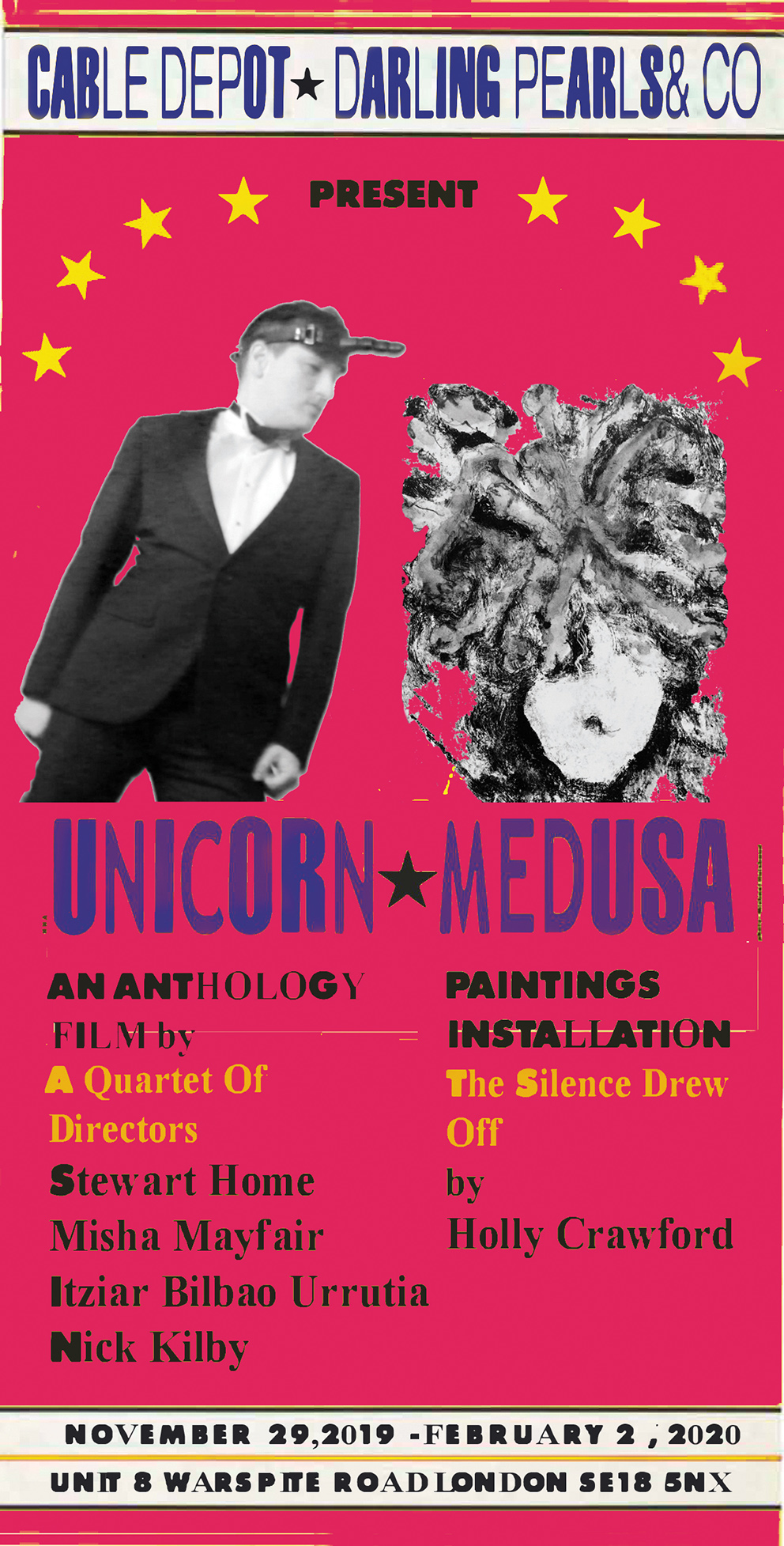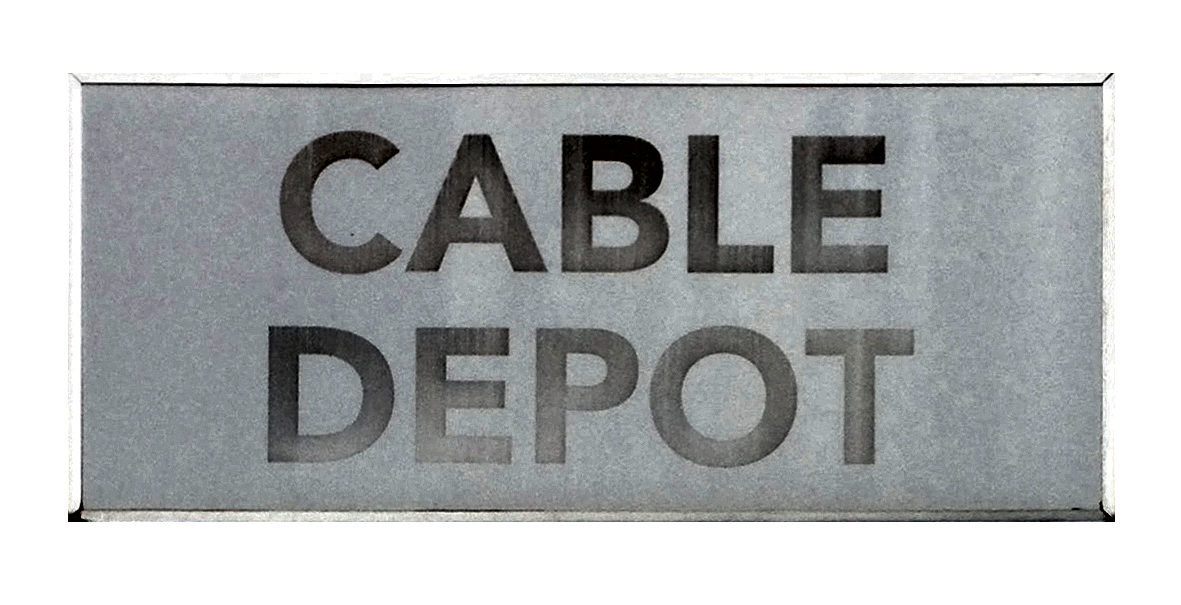UNICORN vs MEDUSA

A Darling Pearls & Co Production in Partnership with Cable Depot.
Holly Crawford | Misha Mayfair | Stewart Home | Itziar Bilbao Urrutia | Nick Kilby
Curated by Alessandra Falbo
@ Cable Depot : Unit 8, Warspite Road, SE18 5NX
Private Reception & Drinks : 29 November 2019, 7-10PM
Exhibition Continues : 30 November 2019 – 2 February 2020
Visits are by appointment only.
To book an appointment & visit call or text +44 7511378063 or email darling.pearls.n.co@gmail.com.
This is not a child friendly exhibition.
Pieces from the series Silence Drew Off, Laughing with Medusa by Holly Crawford are available here <3 !
“True myth may be defined as the reduction to narrative shorthand of ritual mime performed on public festivals, and in many cases recorded pictorially on temple walls, vases, seals, bowls, mirrors, chests, shields, tapestries, and the like. The Chimaera and her fellow calendar-beasts must have figured prominently in these dramatic performances which, with their iconographic and oral records, became the prime authority, or charter, for the religious institutions of each tribe, clan, or city. Their subjects were archaic magic-makings that promoted the fertility or stability of a sacred queendom, or kingdom—queendoms having, it seems, preceded kingdoms throughout the Greek-speaking area—and amendments to these, introduced as circumstances required.” – Robert Graves, 1955
In an epic encounter, the symbolic characters of Unicorn and Medusa are explored from five subjective perspectives. Representations of these mythic creatures date back to the Neolithic period and continue on through Greek mythology, Roman poetry, Biblical history, Hollywood blockbusters, memes, screenshots and a plethora of contemporary consumer products. Since the dawn of history, these myths and our understanding of them have been endlessly remade by political and economic transformations. This show continues that process and takes a close look at how these myths continue to resonate today.
“The myth of the Unicorn is the battle of purity vs filth in human nature. Like the Holy Grail, the Golden Age or various Virgin Births across cultures, it epitomises an ideal that will always be just that: ideal, one step beyond our reach. The unicorn’s horn, like Zeno’s paradox, never fully reaches its target, always seeking his elusive happy ending.” – Itziar Bilbao Urrutia, 2019. The mythological creature had what probably still stands as its first recorded appearance as a carved image in a Hittite temple in Carchemish alongside representations of the Chimaera and the Sphinx (each of the three representing one season of the Queen of Heaven’s sacred year). It is said to also have been mentioned in ancient myths of India and China. A mixture of descriptions within Greek mythology and Christian texts resulted in the fantastical animal (probably initially an Indian rhinoceros) that can be caught only if a virgin maiden is placed in front of it.
In modern times, however, the Unicorn has met a disreputable happy ending. It has lost its job as experts in all things to female purity (probably for the best), but also as poison neutraliser (useful in these days of dark wonder that we’re living). It’s been taken from its perfumed medieval garden, and downgraded to cheap entertainer that graces cartoons, pyjamas and cute plush animals. Like many other creatures and practices of Antiquity, the unicorn is now a toy, entertainment for children and women. The myths of conquered cultures become fairy tales for children in the hands of the conqueror: ancient divination knucklebones become a parlour game; but on a curious reversion of use, playing cards, dice and other games also become sacred magic tools.
Somehow, similarly, Medusa’s myth, often remembered from contemporary adaptations in movies, magazine covers and memes, is an escalated horror story. It was already so in Greek mythology with descriptions that developed from the Archaic all the way into the Hellenistic period. Retold and further developed from these pre-existing sources in Greek mythology, the Roman poet Ovid’s version of the myth ( in books IV and V of his Metamorphosis series – first published in 8AD) describes a beautiful woman made into a monster by a female Goddess for a crime she didn’t commit. She remained speechless only to be hunted by a ‘hero’ who proceeded to use her remains as a tool.
“When Athena discovers Medusa has been raped in her own temple, the mortal woman’s body is transformed, giving her snaky hair and a petrifying gaze. Is there any space within the mythical imaginary for male peccadilloes, whether of art or sexual violence, to be called out without at the same time representing woman as victims?” – Minus Plato, 2019
The above cited author (an entity created from various authors who, for a year’s period, made daily posts on a blog about myths, art and politics which were later edited into the book No Philosopher King: An Everyday Guide to Art and Life Under Trump) offers potential answers to the proposed question in the context of contemporary art. These are also relevant to Holly Crawford’s installation The Silence Drew Off, a piece composed by circa 200 paintings on paper referencing Medusa or, more accurately, a multiplicity of portraits of the most relevant and only mortal of the three sisters joined through their joint fate of being Gorgons. Crawford‘s works on paper include a letter scheme that, indirectly, implies people who have been silenced by the powerful. The installation takes its title from a famous quote found in Sylvia Plath’s only novel The Bell Jar. Crawford is intrigued by its status as a roman à clef and the ways in which such an ‘autobiographical’ work simultaneously accuses and exempts the real world figures semi-fictionally depicted in it from any responsibility for the author’s suicide shortly after its first publication in 1963.
These many Gorgons occupy three walls and some other spots alongside a film called UNICORN, an epic encounter between the Gorgon’s head and the magical horn. Will we end up petrified, purified or both?
UNICORN is an anthology film comprised of four sections directed by Stewart Home, Misha Mayfair, Itziar Bilbao Urrutia and Nick Kilby. Its format a reference to arthouse classics such as RoGoPaG, The Witches, and Coffee and Cigarettes – a format used by, among others, Godard, Pasolini, Jim Jarmusch and Francis Ford Coppola. Titles, as well as the synopsis for the new sketches which have the unicorn as a common theme and protagonist are due to be revealed at the private view of UNICORN vs MEDUSA. During the show magic potions will also be offered to the public.
.
————————————————————————————————————————————
Holly Crawford – “I’m an artist and art historian. I have been an artist my entire life. My artistic practice is complex. It encompasses research, live art, painting, photography, sculpture, sound art, video and installations. For many years now, my practice has been in the grey area between art and activism. Paraphrasing Hannah Arendt in The Human Condition, the public sphere is dynamic and ever changing and through speaking and acting with others we confirm our place in the world and affirm the importance of others. My art gives new meanings and draw categories themselves into question through transformative juxtapositions. The ephemeral, social and institutional critique are areas of artistic interest and research. Different spaces and places are used for exhibitions. Many projects straddle the line between site-specific and serial. Over the years, the installations have become interactive performances. I have exhibited internationally: I’m…who are you? Oh, so sorry. Nothing will happen to me? in the Research Pavilion in Venice. 13 Ways of Looking at a Blackbird site-specific installations in Florence, Valencia, Berlin, London, New York City, Chile and Southern California. Offerings project was a participating .net project at Ars Electronica. Found Punctuation was screened at the Tate Modern in 2007. Sound Art Limo and Critical Conversations in a Limo were part of the Melbourne International Arts Festival in 2007. I’ve written and edited books and papers that include: Attached to the Mouse, 2006 and catalogue essay in, “Disney and Pop” in Once Upon a Time Walt Disney Studio; Artistic Bedfellows, edited, 2008. My Ph.D. is from the University of Essex in Art History and Theory, B.A and M.A. in Economics and M.S. in Behavioral Science from UCLA. From 2004-2006, I was a non-clinical Fellow at NYU Medical School Psychoanalytic Center. I taught at UCLA in the Art Department and SVA. I founded and direct AC Institute, a non-profit space in NYC for experimental work and books. I was born in California, had moved a lot as a child and adult. I now live in New York City environs. I’m a member of AICA-US chapter.” – http://art-poetry.info/
Misha Mayfair is an artist, activist and porn star who experiments with film, identity and performance. Having studied anthropology and having spent years staring in and making porn she explores the Other and the body as socially and psychologically constructed idea and location of politics. Her work uses surrealism, body horror and dreamscapes to express the experience of being a marginalised woman. Misha Mayfair currently works with the journal Acéphale which can be found here: www.thesacredconspiracy.com
Stewart Home is an award-winning visual artist and author of fifteen novels, seven works of cultural commentary, one collection of poetry and one collection of stories. His most recent solo exhibition was Dual Flying Kicks at 5 Years in June 2018. His most recent book is Re-Enter The Dragon: Genre Theory, Brucesploitation & the Sleazy Joys of Lowbrow Cinema (Ledatape Organisation, September 2018). Home was born and lives in London. When he isn’t shredding copies of his own books as live art, he likes to entertain audiences by standing on his head and spewing obscenities. – https://www.stewarthomesociety.org/
Itziar Bilbao Urrutia is a visual artist, activist and pornographer based in London. Her practice is linked to its many sexual subcultures. Her interest in the disobedience of the Monstrous Feminine has led her to explore mediums unrelated to the art tradition, such as porn as a film genre. Since 2004, her projects have been based on an exploration of the international fetish scene as a space of identity and praxis, that lead her to establish her own fetish porn studio, The Urban Chick Supremacy Cell. Using digital adult content as a form of survival and of expression, she mixes the discourse of Femdom with the aesthetics and rhetoric of historical radical action and feminism, such as Valerie Solanas and the Baader-Meinhof group. – https://uc-sc-femdom.com
Nick Kilby is an artist working predominantly within the field of performance art and sound. He is currently undertaking a doctoral program of research at DMU which investigates broken and ruptured masculinities within 20th and 21st Century moving image, alongside the critical need for feminist allyship within the immediate time of a post #MeToo environment. He lives in the North of England. – Instagram @0ddph0d0s
.












































































